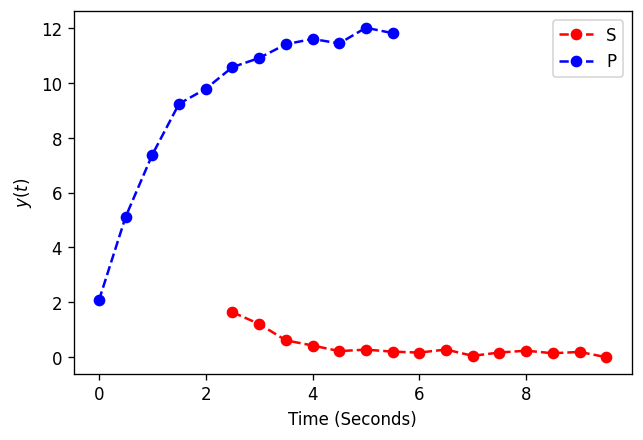%load_ext autoreload
%autoreload 2
import os
os.environ["THEANO_FLAGS"] = "floatX=float64"
import logging
import arviz
import matplotlib.pyplot as plt
import numpy as np
import pymc3 as pm
import theano
import theano.tensor as tt
from scipy.integrate import odeint
# this notebook show DEBUG log messages
logging.getLogger("pymc3").setLevel(logging.DEBUG)
import IPython.display
pymc3.ode:形状和基准测试#
演示场景:简单的酶促反应#
该模型共有两个 ODE 和 3 个参数。
在我们生成的数据中,我们将观察不同时间点的 S 和 P,以演示如何在这些情况下进行切片。
# For reproducibility
np.random.seed(23489)
class Chem:
@staticmethod
def reaction(y, t, p):
S, P = y[0], y[1]
vmax, K_S = p[0], p[1]
dPdt = vmax * (S / K_S + S)
dSdt = -dPdt
return [
dSdt,
dPdt,
]
# Times for observation
times = np.arange(0, 10, 0.5)
red = np.arange(5, len(times))
blue = np.arange(12)
x_obs_1 = times[red]
x_obs_2 = times[blue]
y0_true = (10, 2)
theta_true = vmax, K_S = (0.5, 2)
sigma = 0.2
y_obs = odeint(Chem.reaction, t=times, y0=y0_true, args=(theta_true,))
y_obs_1 = np.random.normal(y_obs[red, 0], sigma)
y_obs_2 = np.random.normal(y_obs[blue, 1], sigma)
fig, ax = plt.subplots(dpi=120)
plt.plot(x_obs_1, y_obs_1, label="S", linestyle="dashed", marker="o", color="red")
plt.plot(x_obs_2, y_obs_2, label="P", linestyle="dashed", marker="o", color="blue")
plt.legend()
plt.xlabel("Time (Seconds)")
plt.ylabel(r"$y(t)$")
plt.show()

# To demonstrate that test-value computation works, but also for debugging
theano.config.compute_test_value = "raise"
theano.config.exception_verbosity = "high"
theano.config.traceback.limit = 100
def get_model():
with pm.Model() as pmodel:
sigma = pm.HalfCauchy("sigma", 1)
vmax = pm.Lognormal("vmax", 0, 1)
K_S = pm.Lognormal("K_S", 0, 1)
s0 = pm.Normal("red_0", mu=10, sigma=2)
y_hat = pm.ode.DifferentialEquation(
func=Chem.reaction, times=times, n_states=len(y0_true), n_theta=len(theta_true)
)(y0=[s0, y0_true[1]], theta=[vmax, K_S], return_sens=False)
red_hat = y_hpt.T[0][red]
blue_hat = y_hpt.T[1][blue]
Y_red = pm.Normal("Y_red", mu=red_hat, sigma=sigma, observed=y_obs_1)
Y_blue = pm.Normal("Y_blue", mu=blue_hat, sigma=sigma, observed=y_obs_2)
return pmodel
def make_benchmark():
pmodel = get_model()
# select input variables & test values
t_inputs = pmodel.cont_vars
# apply transformations as required
test_inputs = (np.log(0.2), np.log(0.5), np.log(1.9), 10)
# create a test function for evaluating the logp value
print("Compiling f_logpt")
f_logpt = theano.function(
inputs=t_inputs,
outputs=[pmodel.logpt],
# with float32, allow downcast because the forward integration is always float64
allow_input_downcast=(theano.config.floatX == "float32"),
)
print(f"Test logpt:")
print(f_logpt(*test_inputs))
# and another test function for evaluating the gradient
print("Compiling f_logpt")
f_grad = theano.function(
inputs=t_inputs,
outputs=tt.grad(pmodel.logpt, t_inputs),
# with float32, allow downcast because the forward integration is always float64
allow_input_downcast=(theano.config.floatX == "float32"),
)
print(f"Test gradient:")
print(f_grad(*test_inputs))
# make a benchmarking function that uses random inputs
# - to avoid cheating by caching
# - to get a more realistic distribution over simulation times
def bm():
f_grad(
np.log(np.random.uniform(0.1, 0.2)),
np.log(np.random.uniform(0.4, 0.6)),
np.log(np.random.uniform(1.9, 2.1)),
np.random.uniform(9, 11),
)
return pmodel, bm
model, benchmark = make_benchmark()
print("\nPerformance:")
%timeit benchmark()
Applied log-transform to sigma and added transformed sigma_log__ to model.
Applied log-transform to vmax and added transformed vmax_log__ to model.
Applied log-transform to K_S and added transformed K_S_log__ to model.
make_node for inputs -5657601466326543627
Compiling f_logpt
Test logpt:
[array(5.73420592)]
Compiling f_logpt
grad w.r.t. inputs -5657601466326543627
Test gradient:
[array(-12.25120609), array(26.04782273), array(-9.38484546), array(11.26454126)]
Performance:
23.7 ms ± 429 µs per loop (mean ± std. dev. of 7 runs, 10 loops each)
检查计算图#
如果您放大顶部的大的 DifferentialEquation 椭圆,您可以沿着蓝色箭头向下查看,以了解梯度直接从原始的 DifferentialEquation Op 节点传递。
theano.printing.pydotprint(tt.grad(model.logpt, model.vmax), "ODE_API_shapes_and_benchmarking.png")
IPython.display.Image("ODE_API_shapes_and_benchmarking.png")
grad w.r.t. inputs -5657601466326543627
The output file is available at ODE_API_shapes_and_benchmarking.png

使用下面的单元格,您可以交互式地可视化计算图。(HTML 文件保存在此 notebook 旁边。)
如果您需要安装 graphviz/pydot,您可以使用以下命令
conda install -c conda-forge python-graphviz
pip install pydot
from theano import d3viz
d3viz.d3viz(model.logpt, "ODE_API_shapes_and_benchmarking.html")
%load_ext watermark
%watermark -n -u -v -iv -w
numpy 1.18.5
pymc3 3.9.0
theano 1.0.4
logging 0.5.1.2
IPython 7.15.0
arviz 0.8.3
last updated: Sat Jun 13 2020
CPython 3.7.7
IPython 7.15.0
watermark 2.0.2